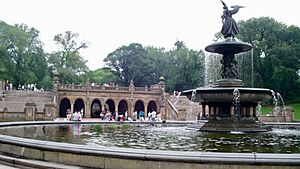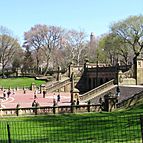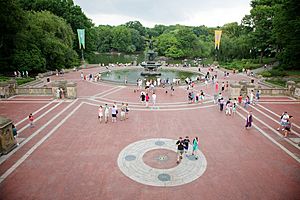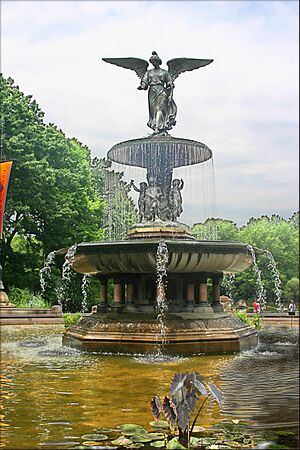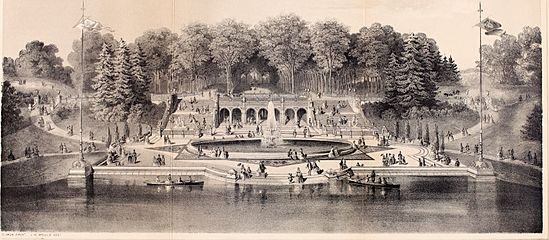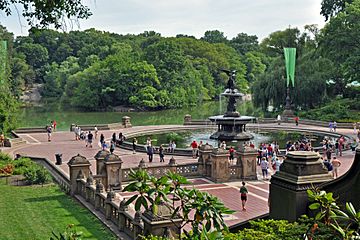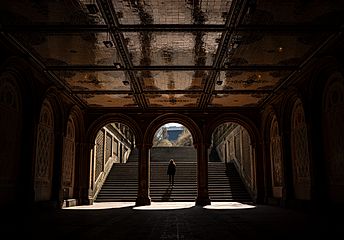Bethesda Terrace and Fountain facts for kids
|
|
Bethesda Terrace and Fountain are two famous spots in New York City's Central Park. They are located near the southern shore of the Lake. The beautiful fountain has a special statue called the Angel of the Waters. It sits right in the middle of the terrace.
Bethesda Terrace has two main levels. Big staircases connect these levels. There's also a smaller passage that goes under Terrace Drive. These paths lead south to the Central Park Mall and the Naumburg Bandshell. The upper part of the terrace is next to the 72nd Street Cross Drive. The lower part is a great place to look out over the Lake. The stone used for the terrace is a special kind from New Brunswick.
Contents
Building the Terrace and Fountain
Bethesda Terrace and Fountain are at the northern end of the Central Park Mall. This Mall was the only formal part planned in the park's first design, called the Greensward Plan.
Building the terrace and fountain happened during the American Civil War. By the end of 1861, work on the terrace was moving fast. The stones for the terrace arrived in 1862. The fountain's stone parts were put in place by 1863. By 1864, most of the stonework for Bethesda Terrace was done. The Central Park team then hired a sculptor to design the figures for the Fountain. The upper level of the Terrace was mostly finished by 1867. Around that time, the Fountain's figures were being made from bronze. Bethesda Fountain was officially finished in 1873.
Bethesda Terrace
The Terrace was designed by Calvert Vaux. The fancy decorations were made by Jacob Wrey Mould. In 1982, the Terrace was fixed up. Its stonework was taken apart, cleaned, and put back together. New grass, trees, and bushes were planted in 1986. However, these plants were later removed in 2008. They were replaced with plants that naturally grow in the United States.
The ceiling of the arcade (a covered walkway) between the stairs had special tiles. These tiles were designed by Mould. They were removed during the 1980s repairs. At first, they were thought to be too expensive to fix. But then, Mayor Ed Koch said in 1987 that the tiles would be restored. They stayed in storage for over 20 years. Finally, a private donation helped pay for their restoration. In 2004, a big project began to bring the tiles back. A team of seven experts cleaned and fixed more than 14,000 original tiles by hand. Only a few new tiles were needed to replace those that were too broken. These new tiles were made by the same company that made the originals. The tiles were put back in place in 2007.
Today, the lower pool of the Terrace once again has water lilies, lotus, and papyrus plants. These plants are grown in special pots that can be moved.
Bethesda Fountain
Bethesda Fountain is the main part of the lower terrace. It was built between 1859 and 1864. The fountain is surrounded by two curved railings.
The fountain's sculpture was designed by Emma Stebbins in 1868. It was shown to the public in 1873. Emma Stebbins was the first woman to get a big public art project in New York City. The bronze statue is eight feet tall. It shows a female angel with wings landing on top of the fountain. Water sprays from where she touches down. It then flows into an upper pool and into the larger pool below. This was the only statue asked for in the park's first design. Below the angel are four small cherub statues. They are four feet tall and represent Temperance, Purity, Health, and Peace.
The statue is also called the Angel of the Waters. It reminds people of a story from the Gospel of John in the Bible. In the story, an angel blesses the Pool of Bethesda, giving it healing powers. In Central Park, the angel represents the Croton Aqueduct. This aqueduct opened in 1842. It gave New York City clean water for the first time. So, the angel holds a lily in one hand, which means purity. With her other hand, she blesses the water below.
The base of the fountain was designed by Calvert Vaux. He was the architect for all the original parts of Central Park. The detailed sculptures were made by Jacob Wrey Mould. In the 1858 Greensward Plan by Calvert Vaux and Frederick Law Olmsted, this area was just called The Water Terrace. But after the angel statue was put in place, its name was changed to Bethesda Terrace.
By the 1970s, Bethesda Fountain was completely dry. But the Central Park Conservancy fixed it up in 1980-1981. This was the first step in their plan to make Central Park beautiful again.
Gallery
Images for kids


